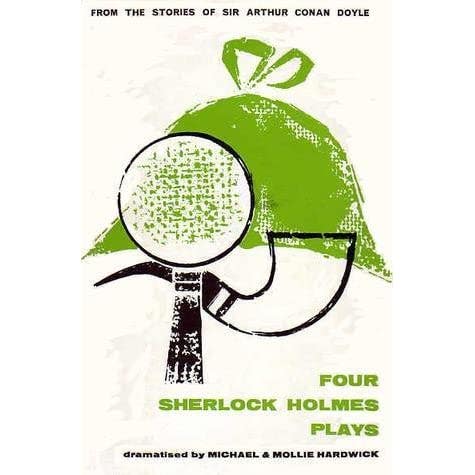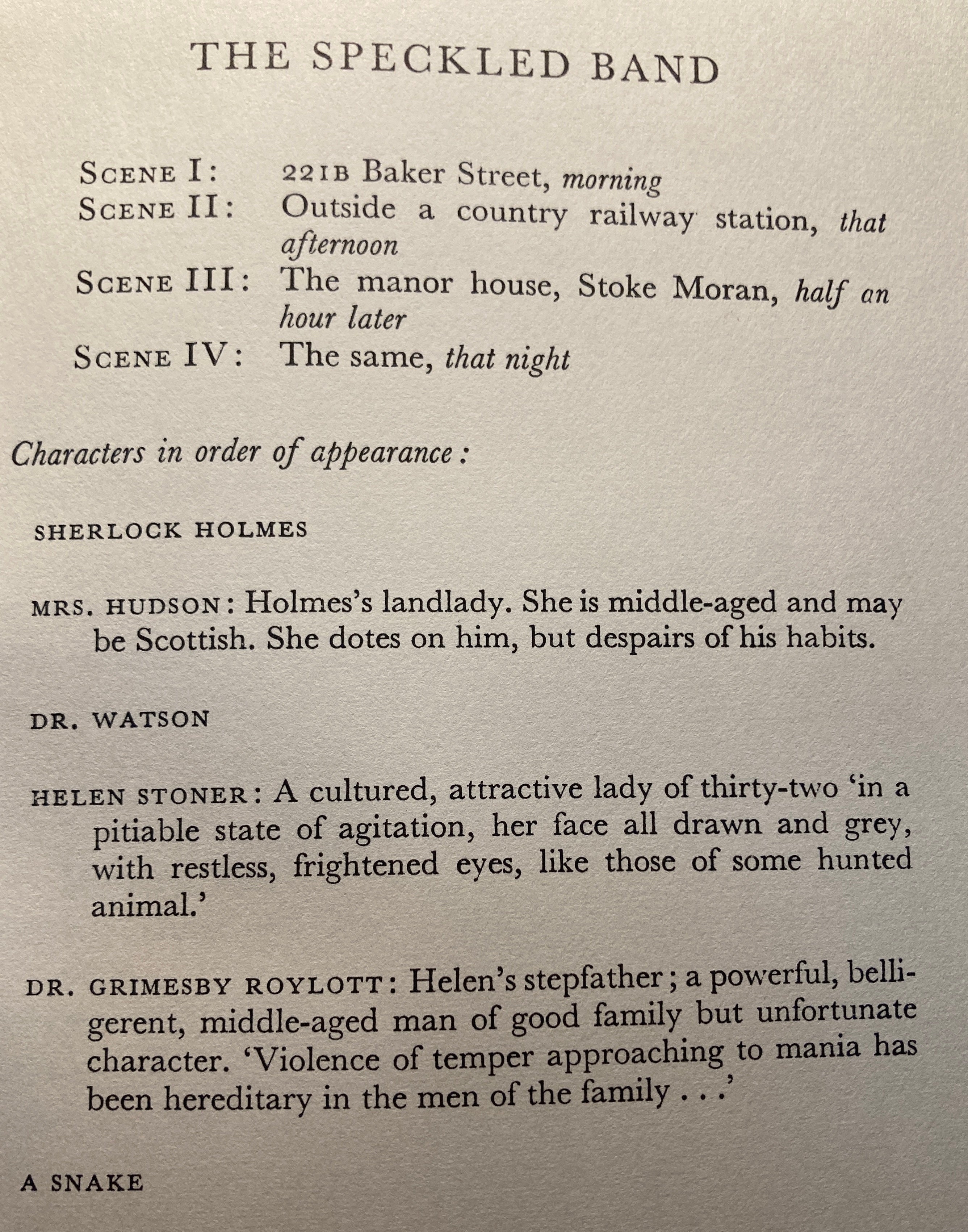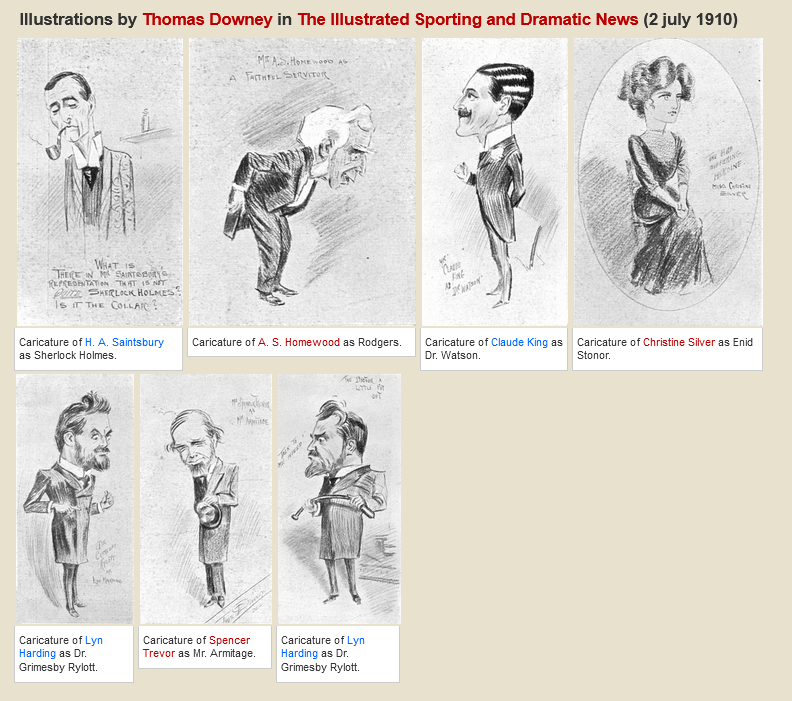The Adventure of the Speckled Band, a one act play dramatized by Michael and Mollie Hardwick, first published 1964

might seem a bit odd to start off this project with a piece like this, but there is import in choosing this one. credit to my sharp memory, i recall that the first sherlock holmes media that i clearly remember consuming was this same one act play in my 7th grade english class. i believe the unit was about script writing and play/film adaptations as we watched part of the Granada TV episode adaptation. i will certainly talk about Granada's sherlock holmes adaptations at a later date.
i have no idea how i'd like to structure these reviews, in the past i typically tried to assign a numerical value to stories i read, but i can't really measure everything against the same scale, especially when there's a lot more to consider in multimedia formats. so this is a little bit of a trial run of working with a bit more of a "formal" review of a specific story. what i will do is mention any specific content warnings for particular kinds of media. i'll do my best to make things non-spoiler if possible, but sometimes there's things that need to be said.
i don't know when or how i acquired the book i read this play in currently, save that it was physically given to me by my mom, but i believe it to contain the same play that i read out as a printed handout from my 7th grade teacher. this book contains three other plays, Charles Augustus Milverton, The Mazarin Stone, and The Blue Carbuncle, however for this first review I will just focus on the Speckled Band.
i was a high school theatre kid, so in fact i really do appreciate the style plays are written in. i really like focusing on dialogue in my own writing work and stage directions make understanding the scope of the scene very easy. i mean, that's rather the point right? to communicate a narrative and actor behavior in the most succinct manner possible. (i feel like i often consider scenes i'm writing as if i'm directing a play, i get caught up in how all the characters are moving around a scene and i wonder if writing a story as a play first and then making it into prose would be easier for me. but i digress.)
i think the original canon of sherlock holmes does lend itself to being rendered as a play adaptation quite well, a lot of stories are just people sitting in calm rooms, sitting and talking through the problems they are facing. the book opens with "NOTES FOR PRODUCERS" that give various tips to people directing or producing these plays for the stage. one thing that i appreciate the most about these notes is this specific quote:
"May we make one plea? That any temptation towards burlesque should sternly be resisted. Cackling villains and the clutching of brows are out! The staid Victorians were not above showing their feelings, but not in the terms of the exaggerated conventions of melodrama."
i really love this quote because this is one of the things i like a lot about the SH canon, even the infamous Professor Moriarty was not a mustache twirling villain, all the antagonists of the original canon are just... people attempting to achieve their goals. there's usually nothing supremely grand or melodramatic about them. this goes for The Speckled Band as well.
this play is quite simple, it's a one act as mentioned before, only four scenes, and in the book i have (which is about half letter sized) it's only 34 pages. i read it only about half an hour while i was doing other things. this story is very difficult to forget, it's incredibly memorable for it's extremely strange elements so this story has always stuck out in my mind.
a summary

a photo i took of the book cast list page. very enchanted by "A Snake" down there at the bottom.
the summary of the story is as follows: a woman named Helen Stoner comes to Holmes with her case. she is soon to be married, but she fears that the death that befell her twin sister two years prior might befall her as well. her sister screamed in the middle of the night, stumbling out of her bedroom stating "it was the speckled band" and died in Helen's arms. Helen heard a whistling sound shortly after the scream, which she only thought she imagined, that is until last night when she heard it again while having to stay in her sister's room due to construction on her own bedroom. Helen's last remaining relative is her step father with whom she still lives with.
Holmes resolves himself to come to her family home today as time is of the essence. Helen is comforted by this and leaves. Before Holmes and Watson can even start discussing their plan, an angry man bursts into the room. it's the step father, Grimesby Roylott. He threatens Holmes to stay out of her and her daughter's business and bends an iron fire poker to make a point. Holmes reacts by just laughing at the guy.
ROYLOTT [infuriated]: You think you can put me off, do you? But I know you, you scoundrel! You're Holmes the Meddler!
[HOLMES chuckles]
Holmes, the busybody!
[HOLMES chuckles louder]
Holmes, the Scotland Yard Jack-in-Office!
[Holmes laughs out loud]
(a "jack-in-office" means "an insolent fellow in authority" according to the Merriam-Webster dictionary.)
Roylott leaves with his threat lingering in the air. Watson wary but Holmes undeterred keep their appointment with Helen to go to her family home and join her there while Roylott is apparently in London on business. the two of them examine the rooms to find that there is a ventilator that connects Roylott and Helen's sister's bedroom, and a dummy bell-wire, as in the thing to call one of the serving staff to your quarters, and the bed is bolted to the floor nearby to the wall with the ventilator. In Roylott's room they find a locked safe, a saucer of milk, and a leash that appears to be too small for even a dog or any of the other apparently exotic animals Roylott keeps in his home. Helen's original bedroom displays no signs of any construction occurring.
Holmes advises Helen to sleep in her original room tonight and they will sneak into the sister's room and observe what happens. Helen obeys and that night Holmes and Watson sneak through the window of the sister's bedroom, waiting for Roylott to go to bed. They wait and soon they hear a hissing sound and observe the speckled band, a snake, coming through the ventilator, crawling down the bell-wire. They hear the whistle and Holmes lashes out at the snake with his cane, scaring it back into the ventilator. They hear Roylott scream from the next room and discover that the snake has made prey of Roylott, presumably in the same way that Roylott intended to do with Helen. Roylott has died of a venomous snake bite. Holmes subdues the snake with the leash, making them safe to approach.
while considering Roylott's body, Holmes lays out that Roylott intended to murder Helen in order to make her birth mother's inheritance all his. he did so with Helen's sister two years prior as well, also just before her marriage. the mother's will stipulated that the sisters would receive their inheritance upon their marriage so Roylott attempted to murder in a way that would not be easily seen by the coroner. they probably wouldn't be able to trace the venom or see the snake bites unless they considered them a possibility and England is far far away from the native grounds of spotted venomous snakes. Roylott apparently trained the snake with milk to enter the ventilator and slither down the bell-wire and return with the sound of a whistle like a snake charmer's pipe. the play ends with Holmes stating that he is indirectly responsible for the death of Roylott but based on the circumstances, it's not going to weigh heavily upon him.
a review and analysis
this story is probably among the ones that require a higher suspension of disbelief to understand the circumstances of the crime. it is certainly fantastical to train a snake to go through a vent, bite a poor woman, and then return at the sound of a whistle. however, what isn't hard to suspend your belief is that a man would kill his step daughters for their inheritance money.
from the outset, Roylott seems like the obvious culprit, however the nomadic or Romani people that Roylott allow to roam his property are presented as a red herring culprit as well. this is due to the window being a possible entrance into the sister's room since her room was locked and maybe the whistling. the Speckled Band was originally printed in 1892 in the Strand Magazine, so this element feels like it was presented as something to play upon the presuppositions of the audience. ACD did this often in his work, presenting very obvious conclusions based on biased thinking. ACD was hardly a non-bigoted person, but to his credit he was aware of what someone with common biases for the time would think: blame the "undesirable" minority people.
speaking to that fact, i think that especially with the fantastical elements of the story, this mystery really asks you to consider all of the clues equally and think about them without applying your personal biases to the information. it becomes clear the the ventilator is the key clue to the mystery once it is seen by Holmes. what could possibly fit in the ventilator? a person could not pass through. there were no obvious signs of violence on the sister so the murder weapon couldn't be something obvious. the other key clue is that Roylott keeps exotic animals around the house, but identifying what animal was used in the murder is much harder if you don't just have an encyclopedia knowledge of animals. it is still possible to imagine a snake however, especially in conjunction with the bell-wire.
in the story, Holmes calls the snake a "swamp adder" however that isn't a real snake. many different prints of this story have considered what the "real" swamp adder was. some of the species posited by "Catalogue of The 1951 Sherlock Holmes Exhibition" are
- Puff Adder
- River-Jack
- Russel's ViperSaw Scaled Viper)
- Temple viper
- Burmese Krait or Spotted Krait
- Cobra
with many of the vipers however, they have slow-acting venom which wouldn't contribute to how quickly Helen's sister or Roylott died in the story. the Kraits have very fast acting venom, however they don't match the coloration as described in the story. of this list, the Cobra appears to be the most likely. in "A Fresh Bite at The Speckled Band" by Philip Cornell it's supposed that the snake could be an Inland Taipan which has fast acting venom, is observed to climb, and has speckled coloration, but it is of Australian origin, where Roylott served and has an affinity with animals found in India. some other animals considered is a Skink, Gila Monster, or Boa Constrictor, however they are less likely due to seeming to need to have been bred for the specific purposes as stated in the story. the fact this is still a huge element of debate to this day is pretty interesting.
this story as a play
speaking to an actual production of The Speckled Band, as directed by the production notes at the start of the book, the sets for the play do not need to be that extensive, save for certain parts of The Speckled Band where seeing the physical clues of the two bedrooms and seeing the snake. this play would be still very easy to pull off with minimal props, minimal sets, and minimal costumes. many people could probably imagine the layout of the flat of 221b without much difficulty and imagine the character of Holmes and Watson by name alone. i think that The Speckled Band story is so iconic that pantomime could even be used for the more difficult to produce elements of the set and it could still be pulled off effectively. according to the production notes, the three act version of The Speckled Band apparently used a real snake in early productions, but then moved to using something closer to what is described as a puppet.
since this is a play, i looked up if i could find any performance recordings online. i can't seem to find any performances of the one act play itself, however i have seem to found previews of performances of what i THINK is the three act play mentioned in the production notes of the book. the ones i found are the trailer of the touring TSF 2022 production, and the character/cast introduction of a high school performance from 1992. i can't be for certain what version of the play they used, but by the sheer number of characters that are present in both videos i think it might be safe to assume that it is the three act version.
what i suspect is that they're actually performing the three act play that ACD adapted himself in 1910! the full script of this version of the play can be found on it's page on the Arthur Conan Doyle Encyclopedia, as well as other materials about the production and advertising that went with it. i'm particularly entranced by the caricature drawings of some of the actors that performed in the initial run of this version: a screenshot of the encyclopedia page displaying seven caricature illustrations by Thomas Downey of actors portraying the characters of Sherlock Holmes, Rodgers, Dr. Watson, Enid Stonor, Dr. Grimesby Rylott, and Mr. Armitage

there are certainly more recent adaptations people have done, and skimming many of the other scripts i've found i obviously can't be certain, every adaptation seems to add more characters than found in the original work. this particular script even adds in a... monkey character?
in conclusion
i was not expecting to go on my own little deep dive learning about the stage adaptions of The Speckled Band just from my own little book of plays of unknown origins. but that's the spirit of investigation, and now i have something else i'll be able to consume at a later date. i would be interested in perhaps doing a follow up to this post just about ACD's play version of The Speckled Band just to see how it compares to his original story and how he dramatized things differently for the stage. i'll also keep an eye out for any performances of The Speckled Band that are available online as actual stage performances. there are plenty of film adaptations, but those are for a different day as well.
The Speckled Band is certainly a story with some staying power though i think, if there are people that are still putting on traveling stage performances of the play to this day. it's incredibly fantastical and unique even within the canon of Sherlock Holmes and while it's probably not something i'd call my favorite, it's one that i'll keep thinking about.
well. i'm not sure how to end this review since it's the first one. if this were a video game review there'd be a score out of 10 with pros and cons so i'll do that.
The Adventure of the Speckled Band, One Act Play
Score: 7/10
Pros:
- fantastic use of suspension of disbelief
- succinct in it's delivery of information
- presents the clues in a way that the audience will be able to figure out
- plays on audience biases
Cons:
- racist language
- violence against women/parental abuse